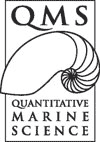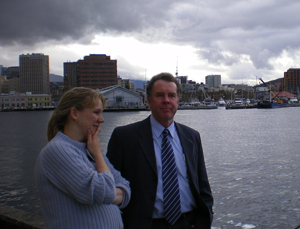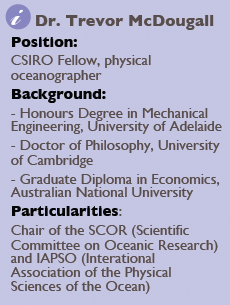

Trevor McDougall is a senior scientist at CSIRO, Hobart. As a physical oceanographer, he applies physical theories to climate models. He also chairs an international scientific committee that is re-defining the thermodynamic properties of seawater. This committee comes under the auspices of the Scientific Committee on Oceanic Research (SCOR) and the International Association of the Physical Sciences of the Ocean (IAPSO).Trevor is proposing a new PhD project through the Quantitative Marine Science (QMS) program on the estimation of diffusion coefficients from ocean hydrography. Here, he explains his science, the creative challenges and why he believes his new PhD project would be an exciting opportunity.
My interest in taking on the role of supervisor is to see the next generation of oceanographers trained properly and bringing on new ideas through programs such as QMS.In the last few years, I have also been chairing a committee charged with providing a new definition of the properties of seawater. In June this year, the Intergovernmental Oceanographic Commission, which represents 140 countries agreed to the new definition. Now we have a new equation for seawater and it provides 26 different properties of seawater; physical oceanographers now can more accurately quantify the ocean's role in transporting heat on planet earth. (For more information see: http://www.csiro.au/news/Science-adopts-new-seawater-definition.html)

Because other fields of science have been around much longer. The application of mathematics to physical oceanography has really only been happening since the 1960's and 70's. That means that if you do have a good idea, it will likely have a lot of impact whereas in other fields, all the good ideas happened in the days of Einstein and now we are just crossing the t's and dotting the i's!
There are more opportunities these days in oceanography in several ways. First of all, there are more opportunities in the sense that if you do make an innovative discovery it can be a basic or fundamental idea, which can have lasting impact in the field of research. It's hard to do that in other fields, even in atmospheric science, which has a 50-70 year head-start on physical oceanography, mostly because they have had better observations over a longer period to resolve the theories. Ocean science is starting to catch up with regional and national data gathering and modelling programs.Oceanography is also a good career choice because of the need to understand climate change. Governments around the world recognize the importance of the oceanography-climate change link. There are positions in this field of science we sometimes find hard to fill because there aren't enough people trained to fill the jobs.
The key to being a good oceanographer is to think differently from everyone else. If you think the same as everyone else, you can get papers published and you can have a reasonable career. But to think differently means that you may come up with quite original ideas that may change oceanographic practice forever.
My areas of research are mixing in the ocean, and thermodynamics. Thermodynamics in the ocean is a new thing for all oceanographers. Mixing is a growing field; if you go to meetings around the world you will find that sessions to do with ocean mixing are full and they operate for several days during the program of a science meeting. The reason for this is that while numerical models are getting better and many of the original problems have been overcome, the remaining issue which all models do need to specify, is a way of putting mixing into the models, a process we call parameterizing. As other model deficiencies are progressively overcome, the unsatisfactory nature of our present mixing parameterizations is becoming more obvious.
The overall goal is to improve the accuracy of climate prediction models. To do this requires much better representation of ocean mixing in these climate models. The present PhD project is concerned with deducing the amount of ocean mixing from ocean observations of temperature and salinity. There are two types of mixing in the ocean: the diapycnal mixing (vertical) and mixing along density surfaces (approximately in the horizontal direction). These mixing processes have very different strengths. The amount of mixing in the two directions is different by a factor of ten million and so it is important to accurately distinguish between the two directions. We see with observations through the ARGO (www.argo.ucsd.edu) program that there is a different amount of heat going in the ocean than the models indicate. We want to understand that better; we think it is mostly because the mixing is not correct in the models.
Hydrography is the name commonly given to the observable parameters: temperature, salinity, pressure. From these measurements we use an inverse model to deduce the things we can't observe (circulation, mixing). A former PhD student of Trevor's, Jan Zika (see Jan's interview), created a Tracer-Contour Inverse model that he says much improved on previous models. This model resolves the strength of mixing processes as well as providing answers on circulation. This technique has been proven to work and now we need to apply this technique for the whole world ocean. The aim is to get maps of mixing intensity, which we can then feed into numerical models. When this is put into climate models there should be a more accurate forecast for climate. I am quite excited by this project and the idea of using observations to deduce circulation and mixing. It has been the holy grail of oceanography for a long time.
For a start, this is an exciting research project. We have a small committed team that gets along well together, in an international oceans research hub located in a city environment with a tradition of ocean exploration and science, and the student gets a fair amount of time with me each week.My advice to a student would be mostly pick the supervisor first and pick the project second. Because the project can change during the course of the PhD but you need a supervisor who has a solid international reputation but who also has the time to spend with the student. Those two things are often in conflict. A third factor is to do a PhD in a group, which is large enough that the student can gain from a larger group of post-docs and students. That's where QMS is good and Hobart is a great environment.
Anaïs van Ditzhuyzen